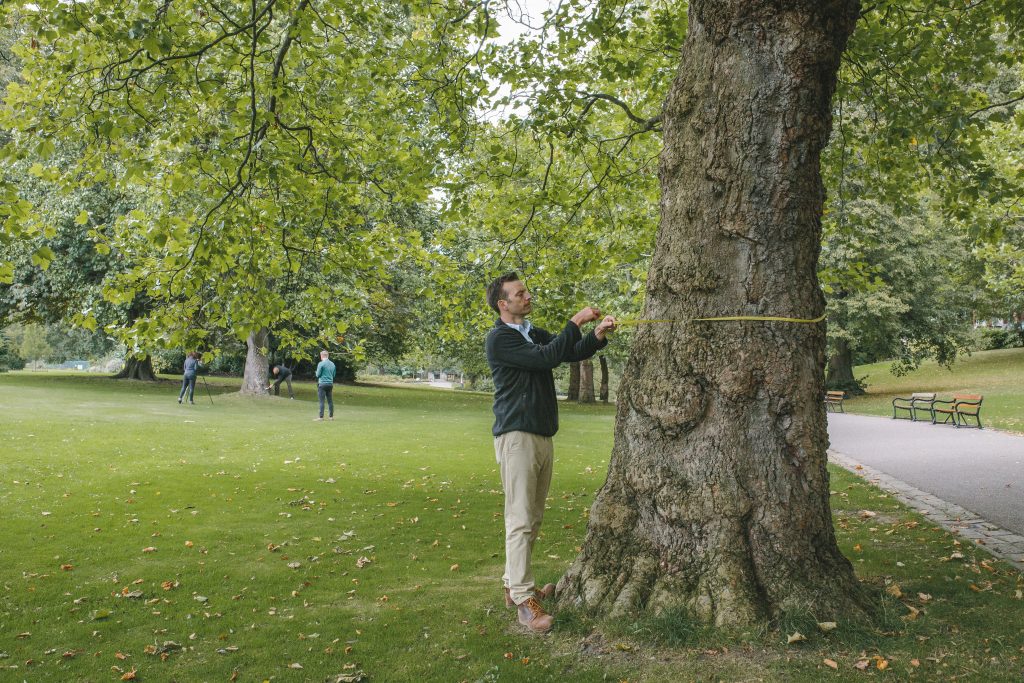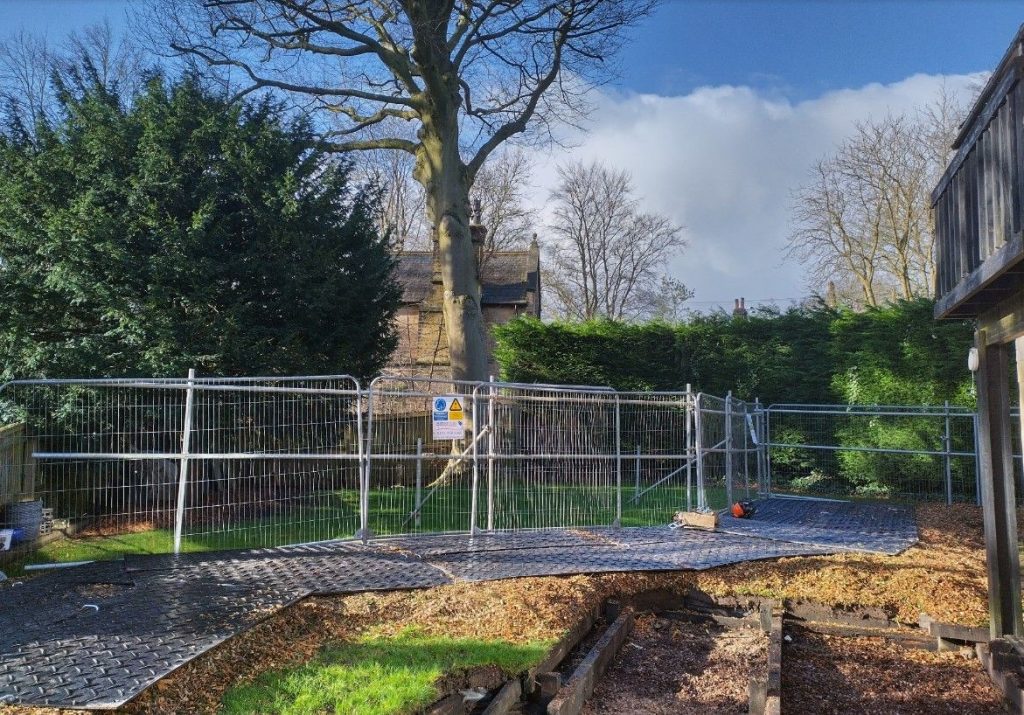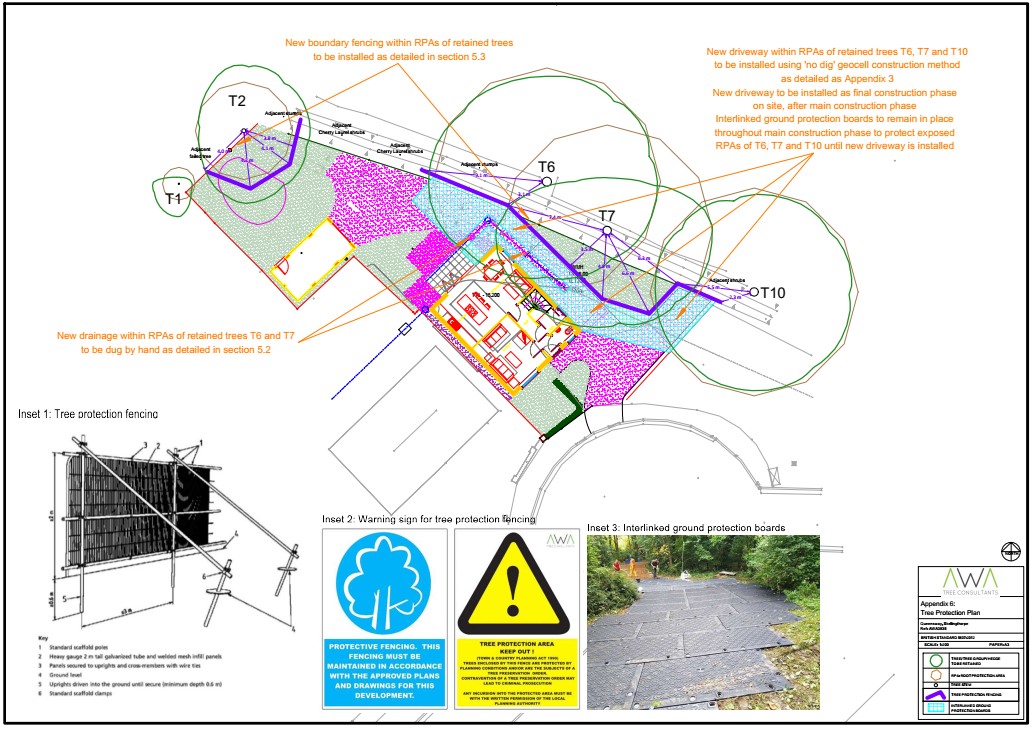Arboricultural Method Statements
Once design proposals are finalised, and the arboricultural impacts have been fully assessed, your local planning authority will hopefully have granted planning permission. As part of this planning permission, the council may condition a detailed Arboricultural Method Statement and Tree Protection Plan.
Arboricultural Method Statements and Tree Protection Plans describe and detail how the trees will be protected and managed during the development of your site. They explain how and when the protection measures will be installed and maintained throughout the development. They are designed to be referenced for practical guidance on how to protect the retained trees at the site to ensure contractors do not accidentally damage trees during construction.
Occasionally councils will want to see the AMS before granting planning permission, and sometimes our clients want to provide these documents up-front, to avoid having additional pre-commencement planning conditions.
At AWA Tree Consultants, we have extensive experience working within the construction industry. As a result, we are able to balance any conflicting interests to ensure that your project runs as smoothly as possible.
How Do Our Arboricultural Method Statements Work?
Our Arboricultural Method Statements and Tree Protection Plans vary in complexity depending on the site, the trees and the development. As a starting point, we use the data we’ve already collected from the tree survey report and arboricultural impact assessment. This avoids the need for additional site visits to prepare these documents.
In many cases, when the site’s trees and the development area are distinct, a more basic document might be all that’s required. This document will detail fencing specifications and timeframes, with a plan showing the location of tree protection fencing. At AWA Trees, we won’t unnecessarily add complexity and expense to the project if it is not needed.


However, if there are high value trees close to or within the working areas of the development, often involving specialist construction techniques, then the Method Statement and Tree Protection Plans will need to be much more detailed.
Our tree experts always like to discuss the project with you if it’s helpful, to get a better idea of how the construction works will take place on the ground.
We have very good relationships with Council tree officers and landscape officers in the area. If required, we can liaise with the officers at the Council to ensure that the tree protection measures are practicable and straight-forward, while still ensuring the information is robust so trees are protected throughout the development.
What Is Included In The Method Statement
As part of your Arboricultural Method Statement, you will receive the following:
- Details of all trees planned for retention and removal
- A detailed schedule of tree works for all the retained trees
- Timing and phasing of works
- Location and specification of tree protection fencing or ground protection
- Site specific demolition and hard surface removal specifications
- Level changes or excavations near to trees
- Site specific construction specifications near root protection areas (in connection with foundations, bridging, SUDs water features, including any specialist ‘no-dig’ hard-surfacing)
- Installation of underground and overground services
- Access arrangements and transportation or car parking
- Storage of materials and siting of cabins and temporary structures
- Movement of machinery and avoiding soil compaction
- Details of any arboricultural supervision schedule, including a schedule of specific events requiring input or supervision
- Contact details of the relevant parties, generally including, the site manager, the council tree officer and the project arboriculturist
Issues Covered By a Tree Protection Plan
Our clear Tree Protection Plans are designed to be easy to use when on site and allow you to view all the key information at all times. All of the important information documented in the Arboricultural Method Statement can also be found in the Tree Protection Plan.
Our Tree Protection Plan will also:

Offer a fully dimensioned drawing that illustrates the required fencing offset distances from existing tree stems.
Highlight other areas of the site needing ground protection or any additional tree protection measures. This means that those undertaking the work on the ground can understand and implement it.
Highlight areas of special construction methods, such as ‘no-dig’ hard surfaces, or specialist pile and beam foundations, near to trees.
On top of this, our Tree Protection Plans make it clear to everyone involved onsite, as to what can happen in relation to the trees, resulting in a smooth construction process with no surprises.
Why Choose AWA Trees?
Arboricultural Method Statements At AWA Tree Consultants
Once planning permission has been granted, it’s important to read all planning conditions carefully. Planning consents often come with tree related conditions added by the local authority, generally in the form of Arboricultural Method Statements and Tree Protection Plans.
AWA Tree Consultants specialise in Arboricultural Method Statements and Tree Protection Plans for planning and development. If needed, we can provide these at very short notice to avoid your project being delayed.
Get in touch with our team of experts today on 0114 2721124 to receive your free quote!


